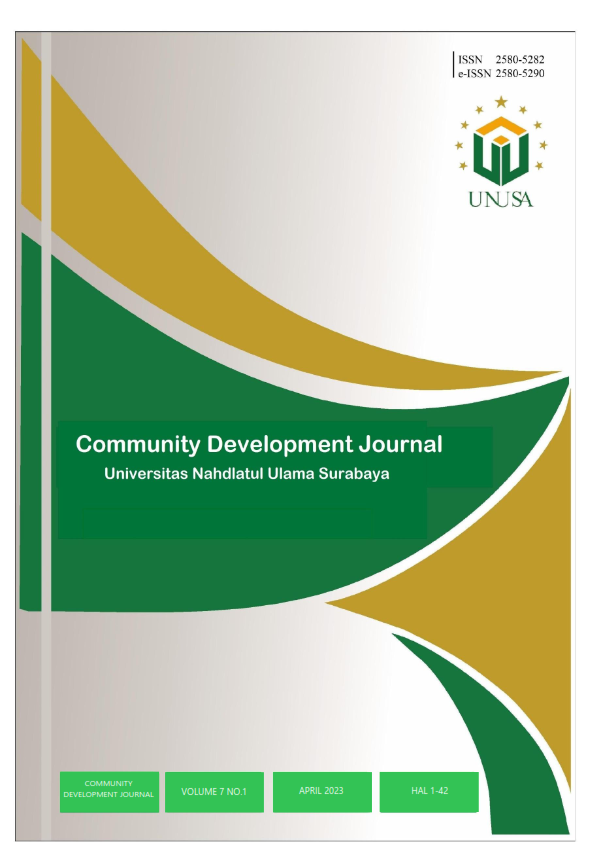Training on the Utilization of Lime to Empower the Lime Farmers in Bolo Village, Gresik
##plugins.themes.bootstrap3.article.main##
Abstract
Lime (Citrus aurantifolia (Christm.) Swingle) is one of the important agricultural commodities for residents in the Bolo village, Gresik. The resident of Bolo Village owns an average of 1/4 hectare of lime plantations. However, the price of lime is not stable. In the harvest season, when conditions become surplus in the market, lime prices often drop, causing losses for the farmers. Lack of knowledge about lime product processing is also an obstacle in the utilization and processing of crops. This community service activity aims to improve the knowledge and skills of citrus farmers in Bolo Village to utilize and process lime crops into Home Industry products, so they do not suffer losses when the lime price drops. Activities are carried out through learning using interactive lecture methods and training through product manufacturing demos. The successful indicator was carried out by evaluating the participants' level of understanding before and after the activity. The training activities significantly increased the participants' knowledge and experience. In addition, this activity also obtained data on the needs of lime farmers. It is hoped that this data can be used for the continuation of the next activity or can also be used by the local government, which wants to help advance agriculture and product diversification in the village of Bolo.
Downloads
##plugins.themes.bootstrap3.article.details##
Copyright (c) 2023 Idha Kusumawati, Sari Retno, Handayani Rosita, Harjono Suko, Yuwono Mochamad, Munandar Tristiana Erawati

This work is licensed under a Creative Commons Attribution-ShareAlike 4.0 International License.
References
Campelo, L. M. L. et al. (2014) ‘Constituintes químicos e estudos toxicológicos do óleo essencial extraído das folhas de Citrus limon Burn (Rutaceae)’, Revista Brasileira de Plantas Medicinais, 15(SUPPL. 1), pp. 708–716. doi: 10.1590/S1516-05722013000500011. DOI: https://doi.org/10.1590/S1516-05722013000500011
Estevam, E. B. B. et al. (2016) ‘Chemical composition and biological activities of the essential oils from the fresh leaves of Citrus limonia osbeck and Citrus latifolia tanaka (rutaceae)’, Revista Virtual de Quimica, 8(6), pp. 1842–1854. doi: 10.21577/1984-6835.20160124. DOI: https://doi.org/10.21577/1984-6835.20160124
Kelebek, H. and Selli, S. (2011) ‘Determination of volatile, phenolic, organic acid and sugar components in a Turkish cv. Dortyol (Citrus sinensis L. Osbeck) orange juice’, Journal of the Science of Food and Agriculture, 91(10), pp. 1855–1862. doi: 10.1002/jsfa.4396. DOI: https://doi.org/10.1002/jsfa.4396
Kore, V. T. and Chakraborty, I. (2015) ‘Efficacy of various techniques on biochemical characteristics and bitterness of pummelo juice’, Journal of Food Science and Technology, 52(9), pp. 6073–6077. doi: 10.1007/s13197-014-1629-7. DOI: https://doi.org/10.1007/s13197-014-1629-7
Kuljarachanan, T., Devahastin, S. and Chiewchan, N. (2009) ‘Evolution of antioxidant compounds in lime residues during drying’, Food Chemistry, 113(4), pp. 944–949. doi: 10.1016/j.foodchem.2008.08.026. DOI: https://doi.org/10.1016/j.foodchem.2008.08.026
Kumari, S. D. and Bandaranayake, H. M. S. P. (2016) ‘Drying Characteristics of Lime ( Citrus aurantifolia [ Christm .] Swingle ) at Different Temperatures’, International Journal of Advanced Engineering Research and Science (IJAERS), (3), pp. 6–8.
Li, L. J. et al. (2019) ‘Citrus taste modification potentials by genetic engineering’, International Journal of Molecular Sciences, 20(24). doi: 10.3390/ijms20246194. DOI: https://doi.org/10.3390/ijms20246194
Lin, L. Y. et al. (2019) ‘Lime (Citrus aurantifolia (Christm.) swingle) essential oils: Volatile compounds, antioxidant capacity, and hypolipidemic effect’, Foods, 8(9). doi: 10.3390/foods8090398. DOI: https://doi.org/10.3390/foods8090398
Lv, X. et al. (2015) ‘Citrus fruits as a treasure trove of active natural metabolites that potentially provide benefits for human health’, Chemistry Central Journal, 9(1), pp. 1–14. doi: 10.1186/s13065-015-0145-9. DOI: https://doi.org/10.1186/s13065-015-0145-9
McIntosh, C. A., Mansell, R. L. and Rouseff, R. L. (1982) ‘Distribution of Limonin in the Fruit Tissues of Nine Grapefruit Cultivars’, Journal of Agricultural and Food Chemistry, 30(4), pp. 689–692. doi: 10.1021/jf00112a016. DOI: https://doi.org/10.1021/jf00112a016
Mongkolkul, P. et al. (2006) ‘Debittering of tangerine Citrus reticulata Blanco juice by β-cyclodextrin polymer’, Journal of Inclusion Phenomena and Macrocyclic Chemistry, 56(1–2), pp. 167–170. doi: 10.1007/s10847-006-9078-1. DOI: https://doi.org/10.1007/s10847-006-9078-1
Purewal, S. S. and Sandhu, K. S. (2021) ‘Debittering of citrus juice by different processing methods: A novel approach for food industry and agro-industrial sector’, Scientia Horticulturae, 276(September 2020), p. 109750. doi: 10.1016/j.scienta.2020.109750. DOI: https://doi.org/10.1016/j.scienta.2020.109750

